Meet the People
STA, 21 August 2022- Roman Uranjek, one of the founders of two the most influential Slovenian contemporary arts collectives, Irwin and Neue Slowenische Kunst, has died aged 60, several media have reported.
Born in Trbovlje in 1961, Uranjek entered the art scene with the Irwins in 1983, creating an an arts phenomenon whose influence stretches from the 1980s to the present.
The group became known for appropriating the iconography of social realism, Nazi propaganda, sacral art and archetypical images of Slovenian art, according to Delo newspaper.
In parallel he pursued his own artistic career and is best known for his project At Least a Cross a Day, which he launched in 2002.
The series contains over 25,000 crosses, a symbol closely associated with Irwin, that he created until his death.
Works by Irwin are part of major international arts collections and have been exhibited in the most prominent galleries in the world.
STA, 5 August 2022 - Kostja Gatnik, a versatile visual artist, has died at the age of 76, his family told the STA. He was best known as an illustrator and comic book author. He received a number of awards, including the Prešeren Prize for lifetime achievement, the country's top accolade in the arts world.
Gatnik also won the Levstik and the Hinko Smrekar prizes for his children's literature and illustration work, respectively.
Born in 1945 in Ljubljana, Gatnik graduated from the Academy of Fine Arts. He was also known as a graphic designer, set designer in film and theatre, photographer and painter, although he was very private about his painting, having told the STA once that he painted for himself alone.
Gatnik's oeuvre is marked by an exploration of visual concepts and communication in the last quarter of the 20th century. His painting, graphic design, illustration and photography share an extraordinary intelligence and rarely seen high standards of quality, read the justification for his Prešeren Prize in 2010.
He entered the Slovenian art scene through pop art and hyperrealism, and in the late 1980s, he made waves with his heightened confessional and self-reflection poetics.
Gatnik illustrated many famous children's books and drew characters that are familiar to almost everyone, including Gal the Dwarf and characters in the frog-inspired book Jure Kvak Kvak (Jure Croak Croak). When it comes to comic books, Magna Purga is likely his most famous work, being a classic of Slovenian comics.
He was laid to rest at a small family funeral on Friday.
STA, 1 July 2022 - Mateja Kos Zabel took office as acting director of the National Museum in Ljubljana on Friday after previous director Pavel Car resigned last month over an art forgery scandal.
Appointed by the Culture Ministry, Zabel previously worked as a curator at the museum's history and applied arts department, and headed the programme management organizational unit.
She will serve as acting director up to a year or until a new fully-fledged director is appointed via an open call.
Zabel, who holds a doctorate in art history and museology, has been working at the National Museum since 1985. She specialises in applied arts, and in recent years she has focused on museology and the role of national museums in the context of modern museum studies. She has lectured art history at the Faculty of Arts in Maribor since 2009.
Her in-depth understanding of the domain and leadership experience have yielded results in her long-standing career at the National Museum, during which she has collaborated with many Slovenian and foreign museums, a press release from the Culture Ministry reads.
She headed two European project groups, many of the museum's projects, as well as a research programme. She also co-authored The Past Under the Microscope exhibition, for which she received the Valvasor Award for an outstanding achievement given out by the Museum Association of Slovenia.
Her predecessor Pavel Car resigned after the Travels exhibition, scheduled to display works from the Boljkovac family collection, including purportedly those of Picasso, Matisse, and Kandinsky, was cancelled last minute following a public outcry over serious forgery concerns.
Car stated he stepped down in order to protect the reputation of the museum and its experts, adding that he had been naive in trusting the wrong person to organize the exhibition.
STA, 14 June 2022 - President Borut Pahor bestowed on Tuesday state decorations on lyricist Elza Budau, choreographer and dancer Edward Clug and conductor Ervin Hartman.
Budau, a poet who penned the lyrics of over 1,000 popular Slovenian songs, including some of the most memorable ones from the golden period of Slovenian chanson, was honoured with the Silver Order of Merit.
"Her texts, together with the melodies of the greatest Slovenian composers of so-called easy going notes, created works of art that have survived for decades and and are today part of the treasury of the nation's collective memory," the president's office said.
Clug, the Romanian-born Slovenian dancer and choreographer, whose works have sold out the Bolshoi Theatre and London Coliseum, also received the Silver Order of Merit.
— Borut Pahor (@BorutPahor) June 14, 2022
Clug started making waves as the main name of the SNG Maribor Ballet company in the 1990s to be appointed the ensemble's artistic director in 2003.
Pahor's office said Clug, the recipient of a number of prestigious international awards, helped SNG Maribor Ballet conquer the world.
Hartman, who has conducted a number of wind orchestras in Slovenia and abroad, was conferred the Medal of Merit for his contribution to the development of wind orchestra music and music culture in Slovenia.
He is the author of the first Slovenian manual for leading a wind orchestra in motion and is credited with the first performances of many Slovenian composers. In 1990 he founded a music publishing house which has published more than 300 mainly novel Slovenian pieces for wind orchestras.
We met on a sunny afternoon, at his property in the old farming part of Logatec, a growing town about 30 minutes’ drive from Ljubljana. Various old but maintained farmhouses, cottages and barns can be found in this part of town by the local stream, that once also served as a public bathing site.
On the left bank of the stream one can find many interesting carved sculptures, most of them arranged on a sunny corner by the public road leading to the nearby supermarkets.
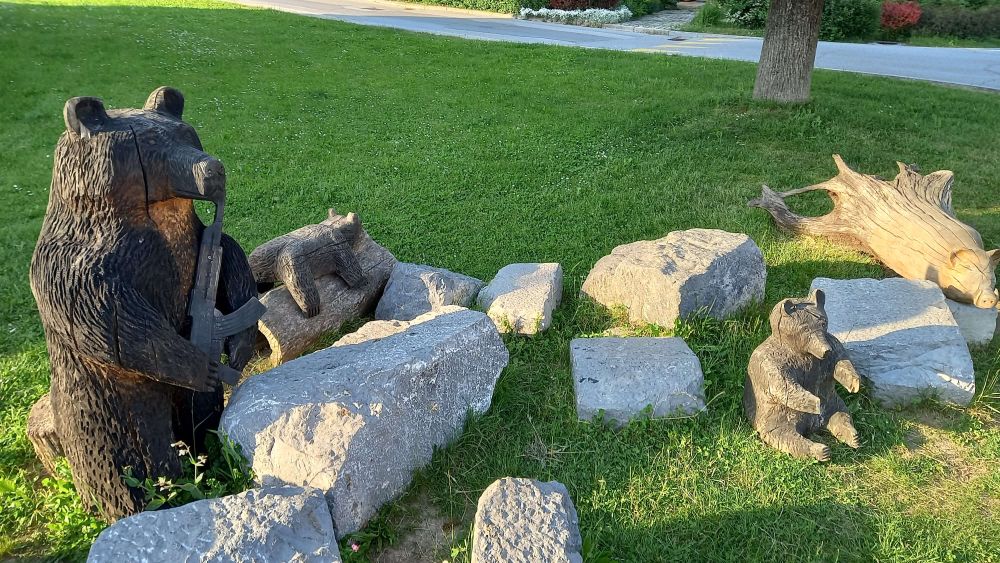
Around the corner of a quaint old farmhouse there is a yard with two sets of outdoor seating arrangements, fitting in perfectly in a rustic style of wood and stone. Here I was warmly welcomed by our interviewee, Gregor Tršar, and presented with a choice of either sitting in the sun or shade.
Before I ask about the sculptures, did you make all these benches and tables yourself?
Yes, I made these myself.
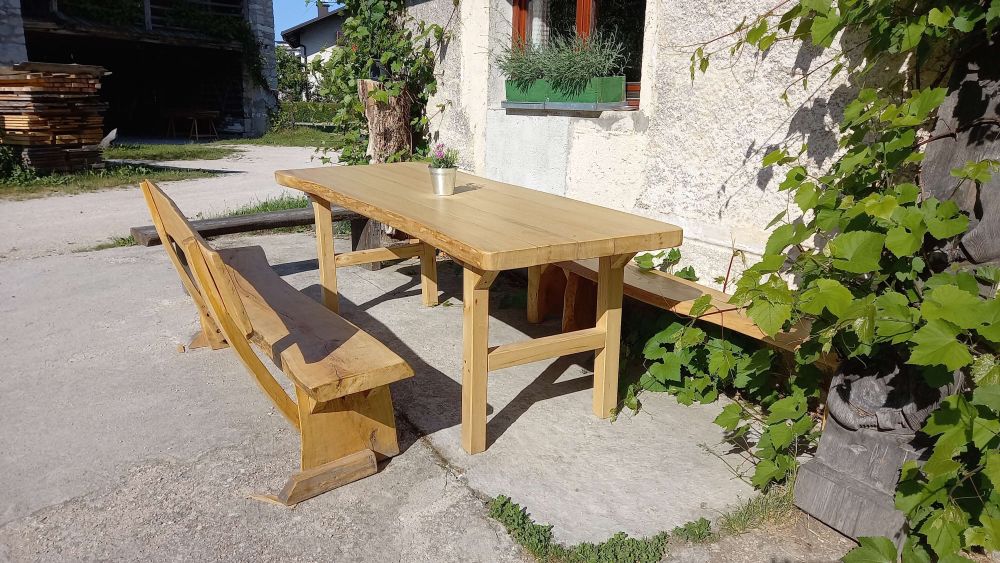
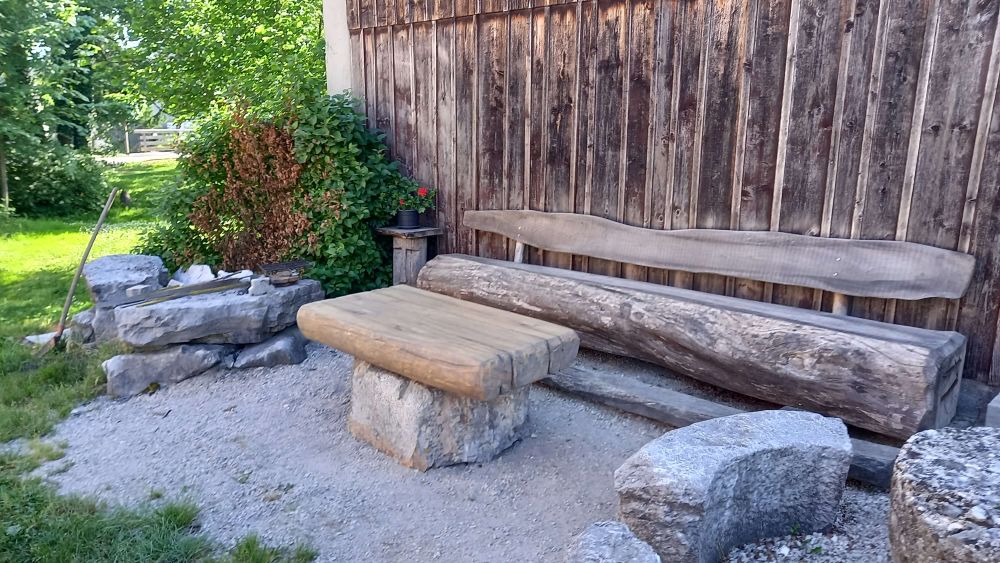
If I wanted one, would you make it for me?
I certainly would.
This space where we are now is a sort of osmica, many people come to hang out, many things happen here. I will show you the insides later.
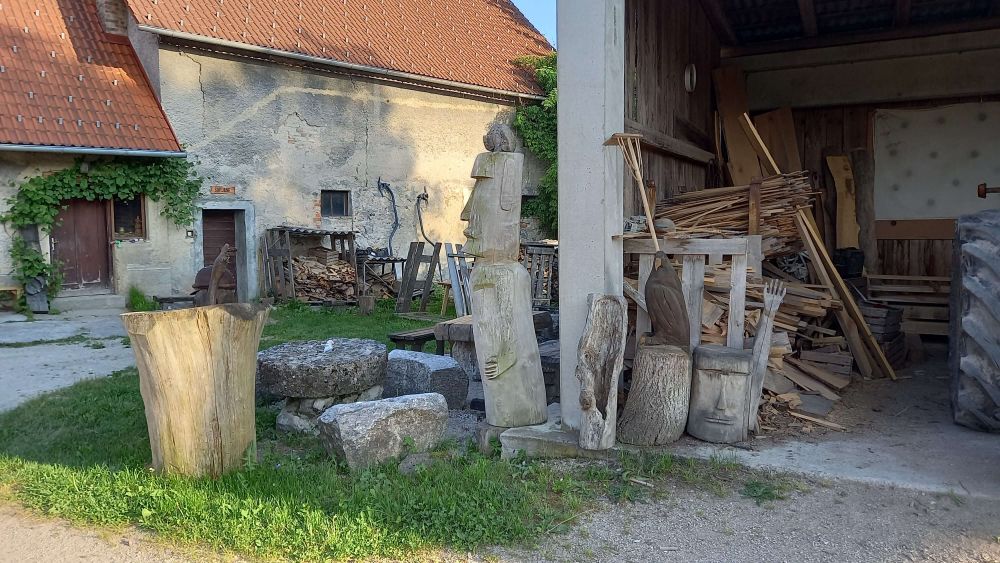
Can I call you an artist?
I would consider myself more like a village weirdo of some sort, regardless of the negative connotation. I don’t push people off my property or forbid them from walking on my grass. I like to see people stop by and children playing around the sculptures.
Older people take a rest on their way from the store and families go out with some goal in their mind, like “let’s go see the bears”.
The sculptures by the side of the road seem like a great contribution to the town. They also reflect a great sense of humour, like the mama bear with an assault rifle...
I decided to make the bear family when they were adopting new legislation about culling bears. I’m not attempting to interfere with any expert opinion, but the bears, just like people like to keep their offspring safe. Since hunters are always the ones carrying rifles, I decided to equip mama bear with one for a change.
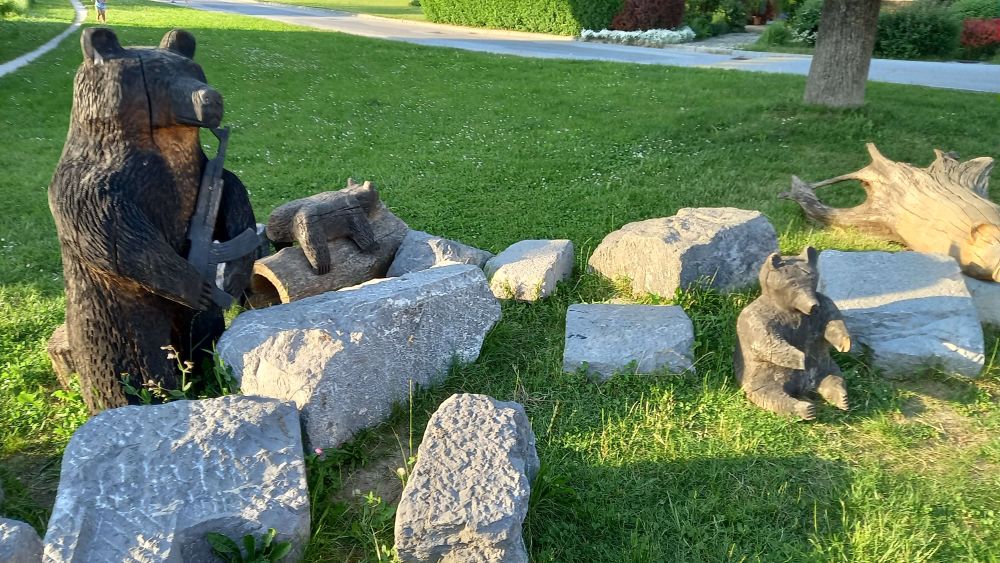
The display also changes through time, I remember once seeing a witch who crashed into a pole on her flight through the town here…
That was about three years ago. Not entirely a wood carved sculpture, but more like a holiday display.

Once I also placed a bench by the road with a bear sitting at one end, so that a visitor was kept company. It’s more interesting if things change over time.
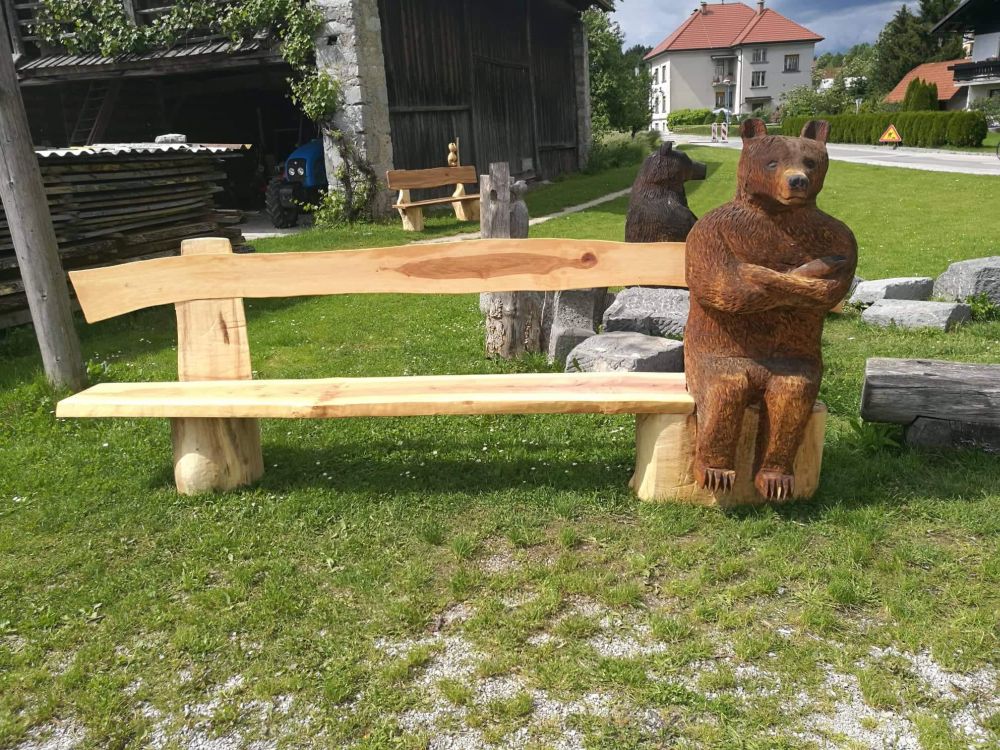
There are also some sculptures I made for other people. For example, an ant (SLO: mravlja) for Mr. Mravlje.
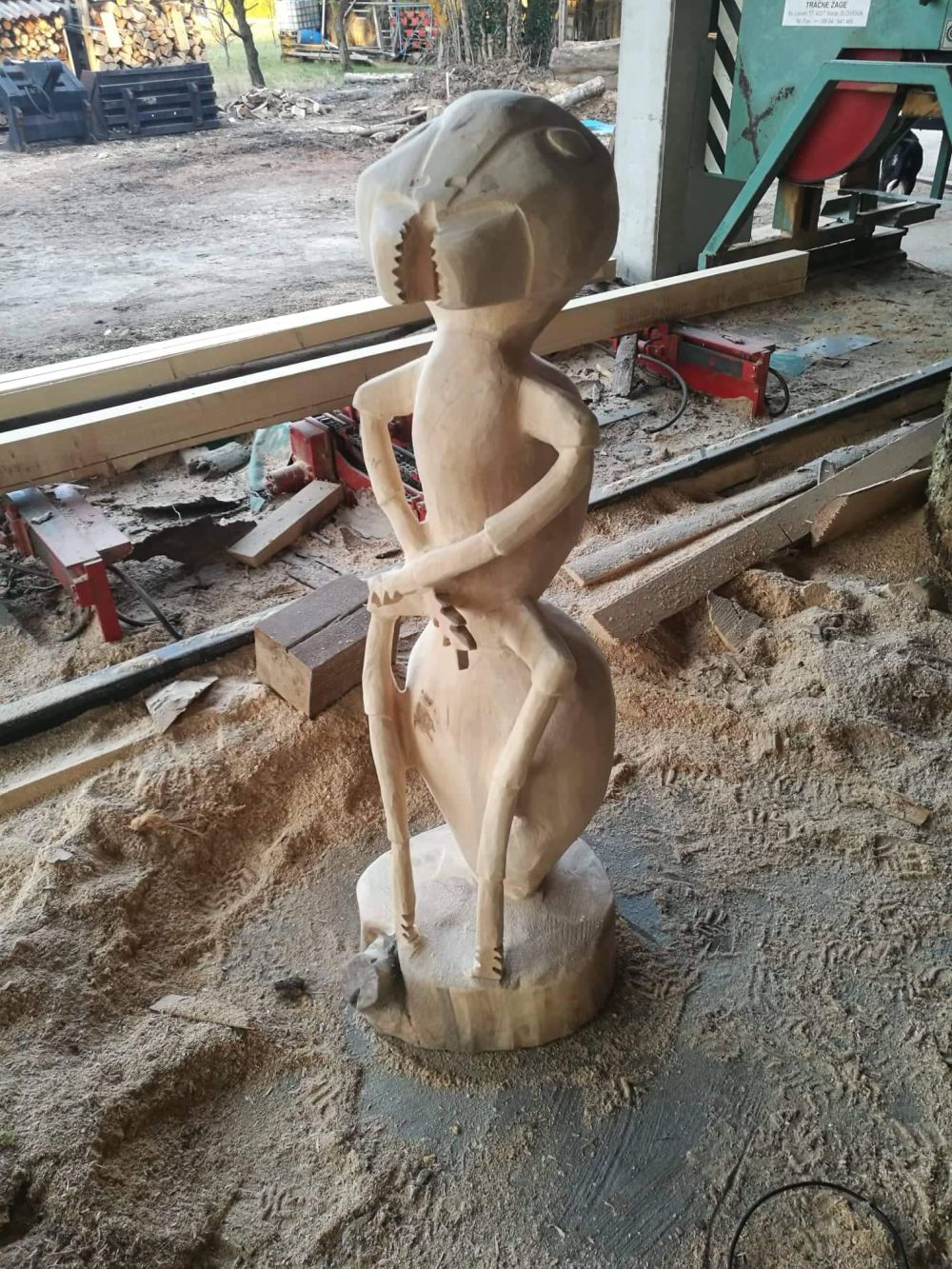
Would you like to see some before and after photos?
I’d love to. Where were they taken?
This is at my friend’s, Diht’nga [a nickname meaning gasket] from Hotedršica. Do you know him? This is at his place.
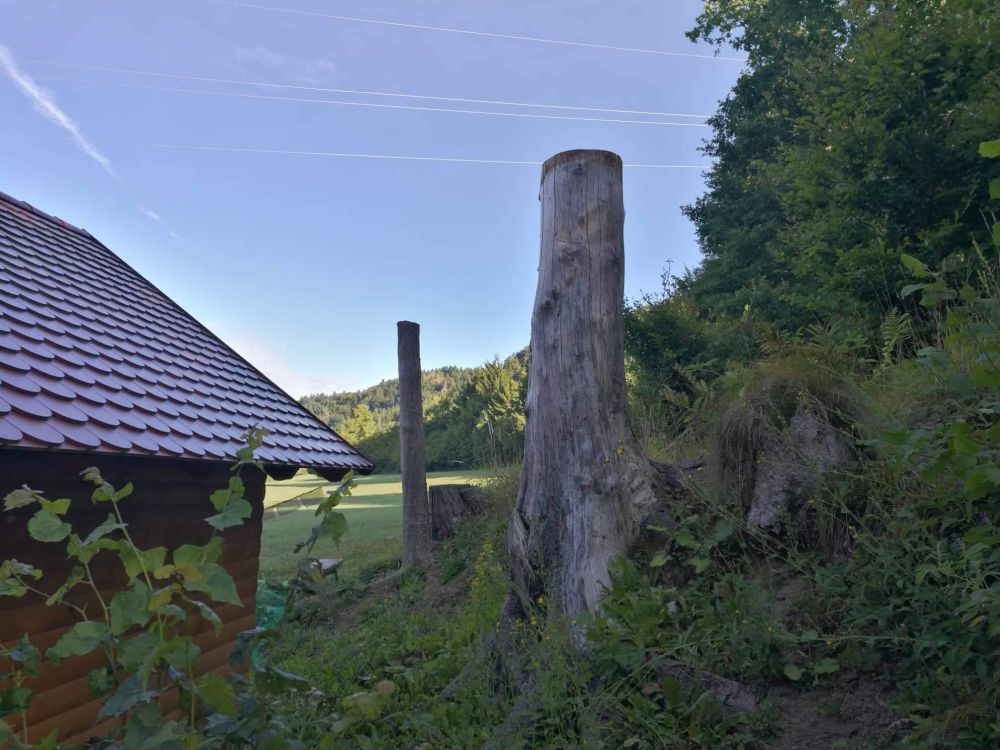

How did you start chainsaw sculpturing?
Two people were responsible for that. One is my colleague Darko Kmetec from Lovrenc in Pohorje. I have a forest there and we collaborated in business. However, through our working together I could see this man had developed many talents in private. He would, for example, see some tree roots and think of creating an interesting chair with them.
The other influential figure in the development of my hobby is Vlado Cencel, the president of the society of chainsaw sculptors. I met him at an event in Postojna.
Are you a member of this society?
Yes, I am. We have a speed carving championship every year at Lavrič’ hut in Gračišče by Stična. Wonderful place, such a good energy. You get 60 minutes to carve something out of a piece of wood, then a team of judges decides the winner.
I ran out of time this year. The important thing, however, is not to win but to take part.
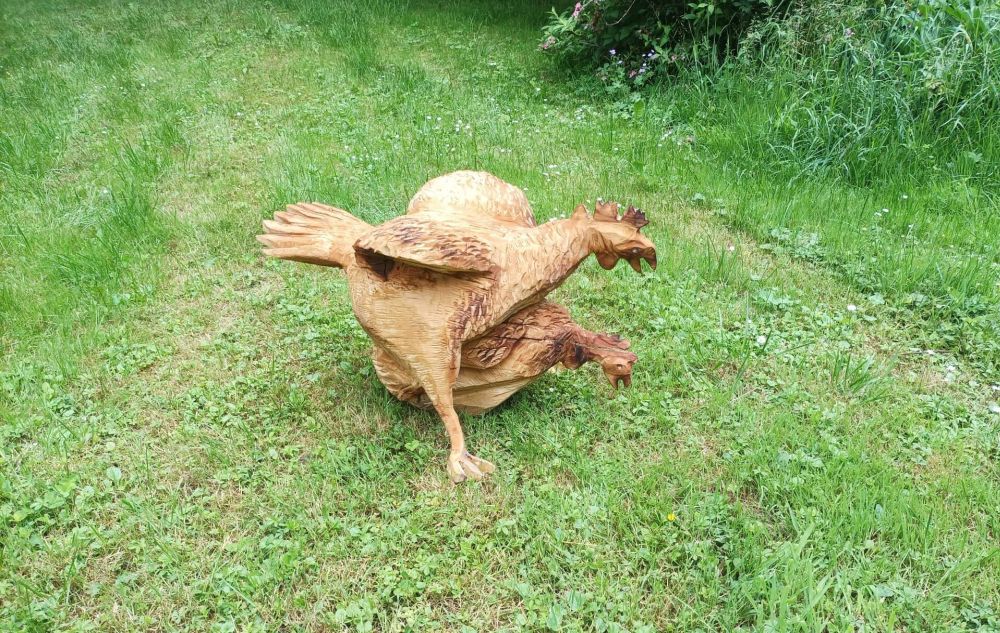
Photo: Gregor Tršar, personal archive
Have you ever won?
I have. I gave the winning sculpture to the chef. He cooked for us all weekend. Whom else should one give a gift, but the one who prepares your food?
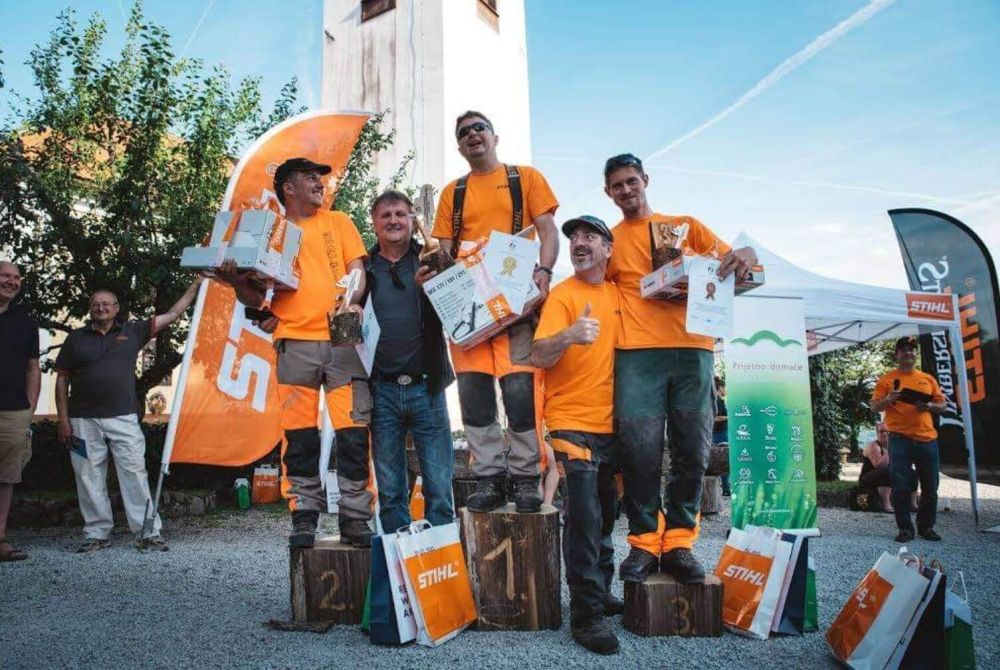
What was the first piece you ever made with a chainsaw?
About ten years ago it all started with this little eagle. My daughter was laughing at me, but I finished it, and it’s staying here. I’d would never give this one away.

(A visitor shows up by in the middle of our conversation. They greet each other and the visitor is told we are having an interview. He introduces himself: the new president of the Pensioners’ Society of Logatec.)
He [the visitor] helped me make wine. The wine of Logatec.
Wine of Logatec?
Would you like to try it? It's made from that vine over there that grows up the barn.
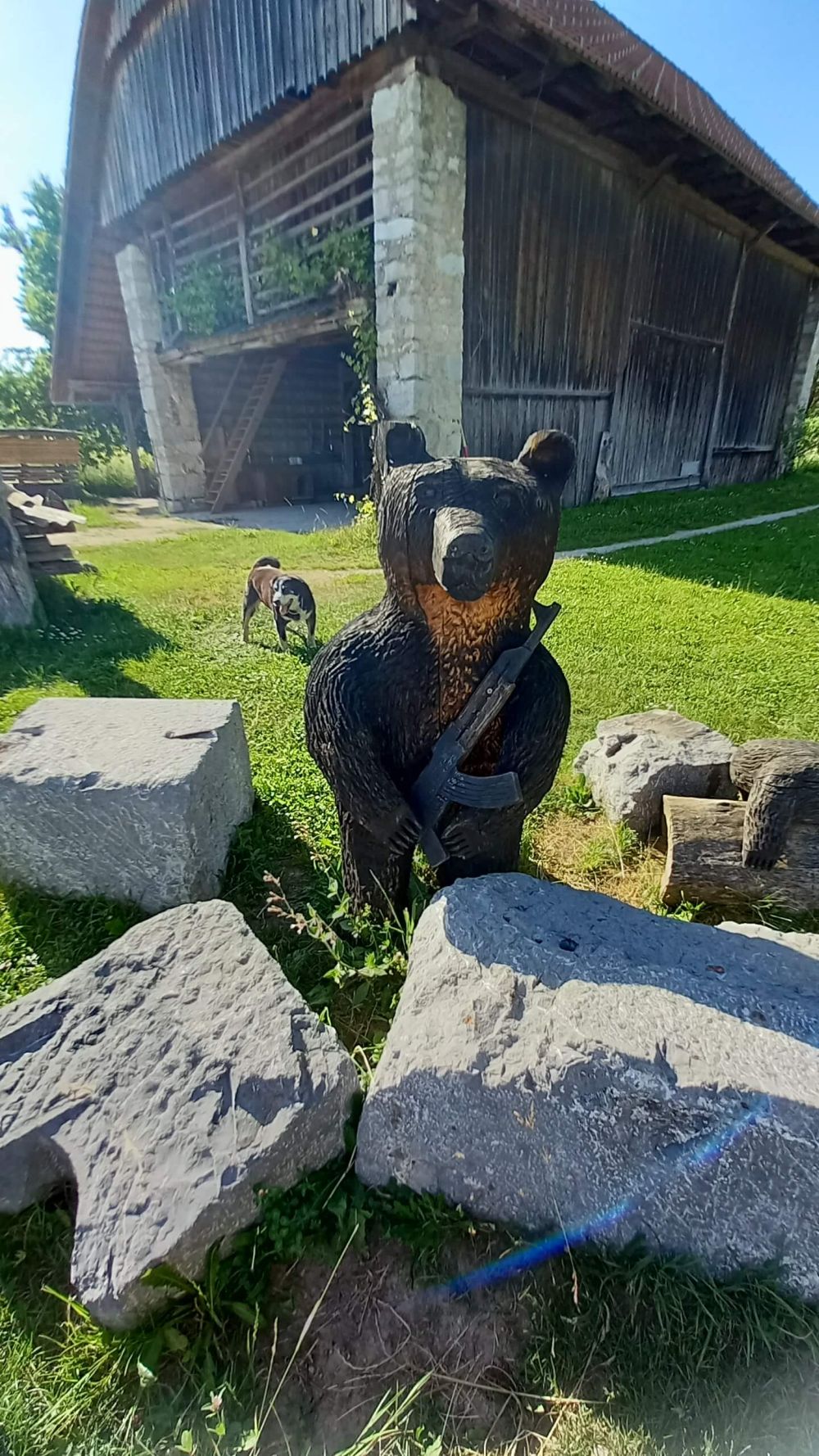
Is it Isabella?
(visitor) No, it has smaller grapes. Isabella needs to be mixed with other grapes for the wine to taste good.
It tastes great! How did you make it?
I made wine must and he made it into wine.
- [Visitor] I told him how to do it.
I put must into a big bottle (SLO: flaškon), added a bit of sugar, I also bought a vent peg, which lets the air out but not in. Wine clears itself this way.
- [Visitor] It’s strong, 12.5 % alcohol.
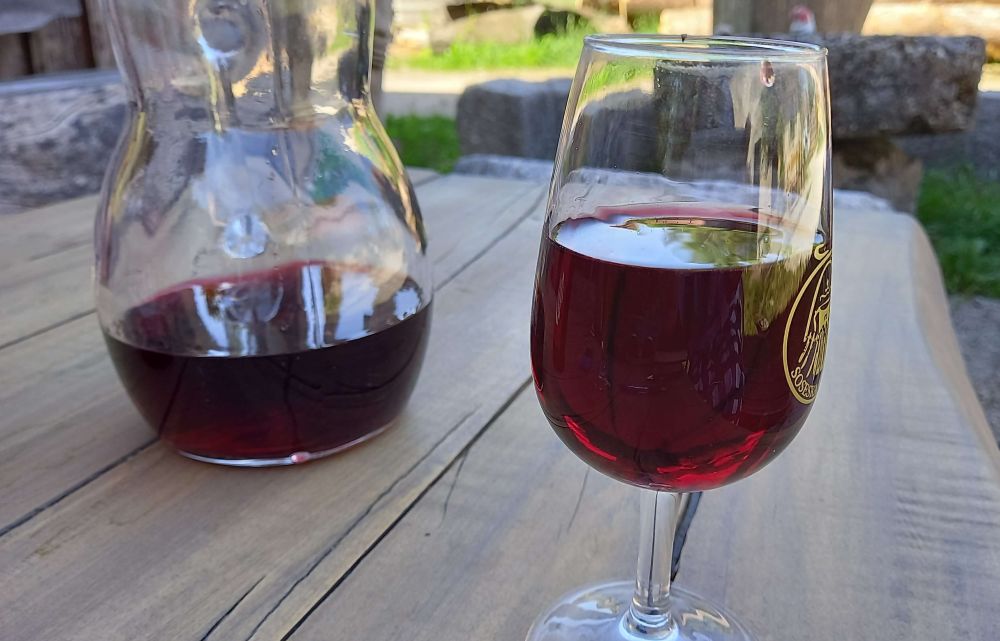
I noticed a cute pit latrine toilet in the back of the barn, is it functional?
This is not a toilet to be used.
Once we were joking how we should make a toilet on the platform above the stream. Friends then got me this as a gift for my 50th birthday.

Do not try to use that toilet! Photo: Neža Loštrek
We then put it on the platform above the stream, no hole was made in the platform, of course, but it did look as if it had one. You could see it from the bridge and some ladies, not realising it was a joke, were quite appalled: “how could such a thing even be allowed!?” they wondered.

End of the pier relief Photo: Gregor Tršar, personal archive
There is a “thinker” standing on that platform now. People tend to stop at the bridge and look at the stream, so he’s there looking back at them.

Photo: Neža Loštrek
Let me show you the chainsaw museum I keep inside.
Chainsaw museum?
Yes. A person dies and their chainsaw remains.


Photo: Neža Loštrek
What's that little piece of wood on the wall that says, “remove in case of war”. What's behind it?
Remove it and you'll see.
I better wait for the war first.
That's the right answer. (laughs)
I’m guessing nothing’s behind that piece of wood but the wall, but I hope we never need to find out.

Another practice piece for the speed carving competition. Only part of it survived the test of time and it now helps to warn visitors away from the toilet. Photo: Gregor Tršar, personal archive
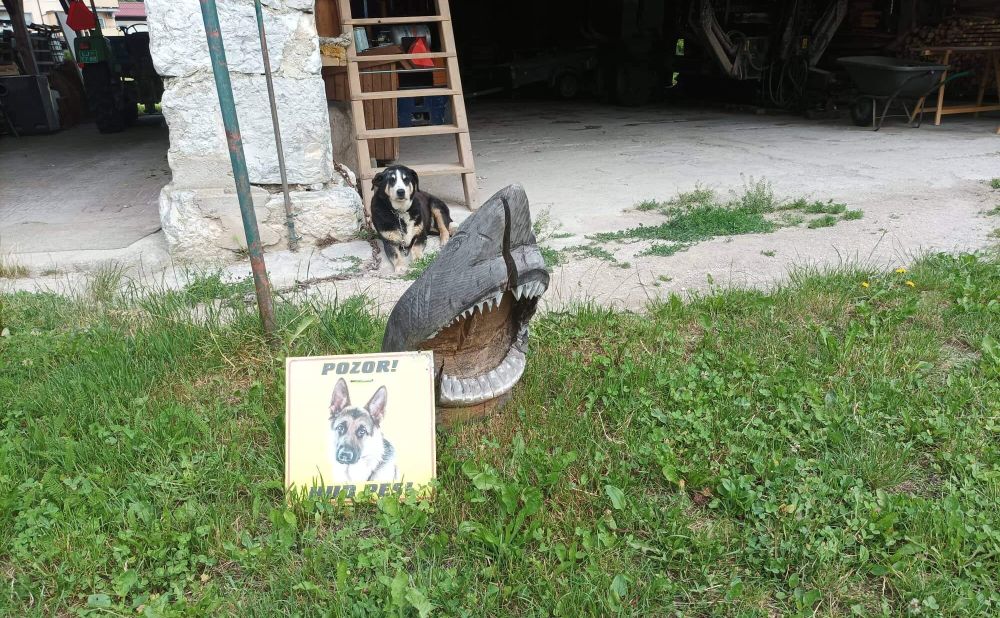
A joke that only works in Slovenian. Photo: Gregor Tršar, personal archive
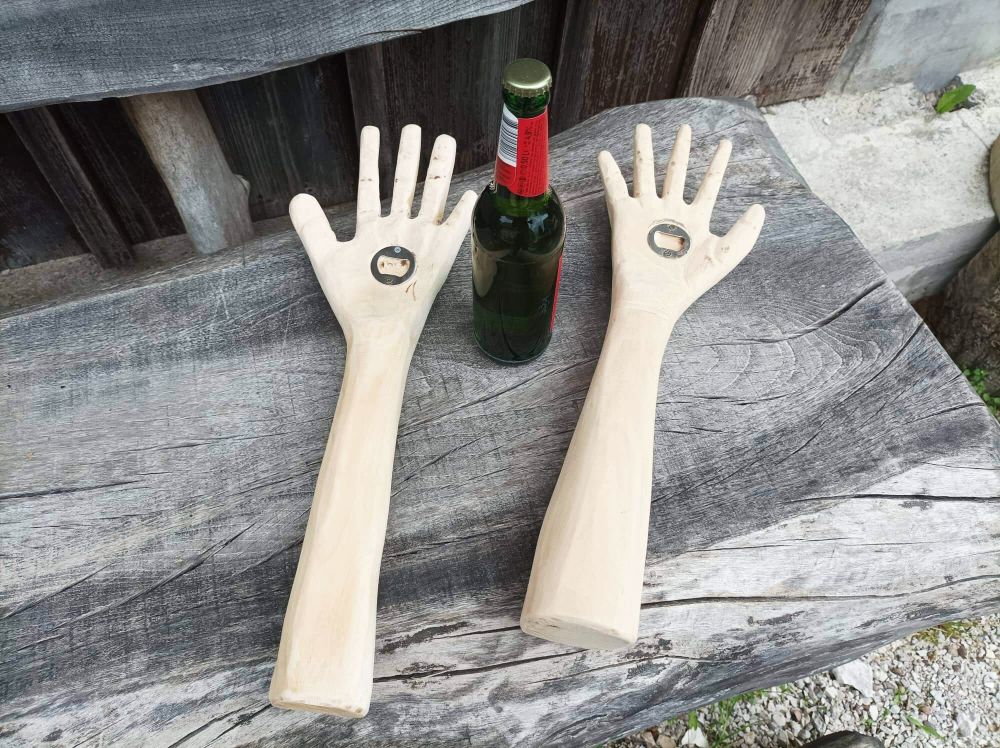
Happy hands Photo: Gregor Tršar, personal archive
STA, 30 May 2022 - Boris Pahor, the internationally-renowned Trieste-born Slovenian writer who wrote about his own experience of Fascism and the suffering in Nazi death camps during World War II, has died at his home in Trieste, aged 108, Radio Slovenija has reported.
Pahor spent his life raising awareness of the dangers of totalitarian regimes the kind of which he had been a victim of himself. He described his experience of being interned in Nazi concentration camps in Necropolis, the award-winning novel that brought him fame across Europe.
Born into a Slovenian family in the multicultural city of Trieste in the Austro-Hungarian Empire on 26 August 1913, a year before the outbreak of World War I, Pahor witnessed the rise of Fascism in Italy as a child.
In 1920 he saw how the Fascists burnt down Narodni Dom (National Hall), the hub of the Slovenian community in the city, which the community would not get back until a hundred years later.
As a young intellectual, he associated with Slovenian anti-Fascist intellectuals and activists in Trieste. In 1940, he was drafted into the Italian army and sent to fight in Libya and was then transferred to Lombardy, where he worked as a military translator in a camp for Yugoslav POWs.
After Italy's capitulation in 1943, he joined the Slovenian resistance movement. However, in January 1944 he was captured by the Domobranci, a Slovenian pro-Nazi militia, and handed over to Germans, who sent him to several different concentration camps.
In Necropolis he revisits the Natzweiler-Struthof camp twenty years after his relocation to Dachau. Following Dachau, he was relocated three more times: to Mittelbau-Dora, Harzungen and finally to Bergen-Belsen, which was liberated in April 1945.
The novel would not bring him international acclaim until after it was translated into Italian as late as 2007, 40 years after it first came out in Slovenian in Italy. It was translated into French as early as 1990.
A committed democrat, Pahor in 1966 founded Zaliv (The Bay), a magazine in which he advocated democratic values against the Yugoslav communist regime.
In 1975 he published an interview with Edvard Kocbek (1904-1981) in which the Slovenian dissident condemned the summary killing of 11,000 Slovenian Domobranci by the Yugoslav authorities immediately after World War II.
Bringing up a taboo topic, the interview earned him a four-year ban to enter Yugoslavia, and it took until after Slovenia gained independence from Yugoslavia that his homeland's relationship with him eased.
As a result, his work was honoured with the country's top accolade for artistic achievement, the Prešeren Prize, in 1992, after which he would turn into a moral authority who Slovenians looked up to.
His books, which deal mostly with the Slovenian minority in Italy and his experience of Fascism and war, won him many accolades, including the French Legion of Honour, Austria's Cross of Honour for Science and Art and several nominations for the Nobel Prize in Literature.
He was decorated by Slovenia's president of the time, Milan Kučan, in 2000 and had been a full member of the Slovenian Academy of Sciences and Arts since 2009. On turning 102 he was named Slovenia's cultural ambassador.
A committed fighter for the rights of endangered languages and cultures, Pahor always argued that national awareness was vital to the survival of Slovenians in Italy and the survival of the world's humanity.
When National Hall was returned to the Slovenian community in Trieste in 2020, the presidents of Slovenia and Italy, Borut Pahor and Sergio Mattarella, honoured the writer with the highest state decorations.
Talking with the STA at the time, he called on the Italian authorities to publish a report compiled by historians from both countries on the period between 1880 and 1956, which he believed should found its way into textbooks. He was concerned about a return of Fascism.
In 2009 Pahor declined to accept the Trieste award for his role in culture, suffering under the Nazi occupation and opposition to the Yugoslav communist regime, saying the justification of the award failed to mention his opposition to Italian Fascism.
A year later he also declined the honorary title of a Freeman of Ljubljana, arguing the Slovenian capital had behaved as a stepmother to the western region of Primorska after World War I.
He has been immortalised in several documentaries, including the BBC's 2019 documentary The Man Who Saw Too Much, which portrayed him as the oldest still living survivor of a Nazi concentration camp. Along with Kocbek, Pahor has a life-size monument in Ljubljana's Tivoli Park.
Even in his final years, his main mission was to share his memories, of how as a young boy he was robbed of his mother tongue, of his experience of Nazism and other totalitarian regimes of the 20th century, with young people, seeing a hope for a better future in them.
At the time of refugee crisis and a series of terrorist attacks in Europe, he called for dialogue guided by reason as a way to a solution, arguing the only hope for the world was to resist wars, barbarism and desire for dominance and to respect diversity.
STA, 25 May 2022 - Composer Damijan Močnik is the winner of the 2022 Kozina Award, the top honour for this art form, which is given out by the Slovenian Composers' Association. Močnik is being honoured for his well rounded sacral oeuvre, says Wednesday's press release by the association, which will present the award to the composer on 2 June.
Močnik, who was also one of six artists to win the prestigious Prešeren Fund Prize this year, was born in 1967 in Kranj. He graduated in composition from the Academy of Music in Ljubljana and then studied abroad, mainly in choir conducting, including with the acclaimed choirmaster Eric Ericson.
He works as a professor of music, choirmaster and director of musical activities at the Diocesan Classical Gymnasium at the St Stanislaus Institute in Ljubljana, where he and his colleagues have built the so-called choral pyramid, a hierarchical system of seven choirs.
One of them is the Megaron Chamber Choir, which was founded in 2003 and has developed into one of the most acclaimed Slovenian choirs.
Močnik also participates in the professional and artistic councils of choral events, lectures at courses and professional meetings, and is a member of juries at choral competitions at home and abroad.
As a composer, he explores choral, a cappella and vocal-instrumental music. He is currently one of the most frequently performed contemporary Slovenian composers abroad, according to the Megaron Chamber Choir website.
The Kozina Award, named after composer Marjan Kozina (1907-1966), has been conferred by the Composers' Association since 1994.
STA, 20 May 2022 - Comic book artist Izar Lunaček was conferred on Thursday the French Order of Arts and Letters. He received the honour for his contribution to the promotion of comic books, the popularisation of French culture in Slovenia and the strengthening of ties between France and Slovenia this field.
The French Institute in Slovenia said Lunaček, who received the knight grade of the order, has become one of the most important advocates of French-Slovenian relations in the field of comics over the last 15 years.
Hier soir à la Résidence de France, décoration du bédéiste #IzarLunaček au rang de Chevalier des Arts et des Lettres ? pour son travail colossal en faveur de la coopération franco-slovène ???? dans le domaine du 9ème art ✍?
— Institut français SI (@IFSlovenie) May 20, 2022
Félicitations !@SLOinFRA @IFParis @CiteBd #Stripolis pic.twitter.com/sf06A0YJKY
In addition to his prolific artistic activity, the 43-year-old has spent a decade at the helm of the Stripolis association, a major factor in the promotion of comics among the general public.
The Tinta Festival, formerly Stripolisfest, which he co-founded, is now an unmissable event for professionals and experts as well as enthusiasts.
Lunaček, who was also one of the forerunners of the concept of the Drawn Concert in Slovenia, is a great connoisseur of the Angouleme International Comics Festival in France where he has established precious ties with French authors and publishers there.
In 2020, Stripolis became a publishing house that has already published several Slovenian translations of French comic books.
Lunaček, who is moreover painter, comparativist and philosopher, received the honour from French Ambassador to Slovenia Florence Ferrari.
STA, 17 May 2022 - Mathematician Franc Forstnerič, a professor at the Ljubljana Faculty of Mathematics and Physics, is one of the three Slovenians who won the prestigious ERC Advanced Grant for established researchers this year. Maths is about creating order in the universe, says the recipient of the first ERC project for mathematics in Slovenia.
Forstnerič received the European Research Council (ERC) five-year grant worth nearly EUR 1.5 million for his project titled Holomorphic Partial Differential Relations, which is aimed at coming up with new methods and findings in the area of Oka manifolds and more generally of oriented holomorphic systems.
In 1985, Forstnerič completed his doctoral thesis about holomorphic mappings in several complex variables at the University of Washington in Seattle, US.
During his studies, he was introduced to the Oka-Grauert principle, which deals with the existence and properties of holomorphic mappings from certain classes of complex manifolds. At the time, he lacked the "mathematical maturity" he now has to build on the principle, he told the STA.
After he obtained his PhD, Forstnerič first returned to Ljubljana and then went on several extended research stays abroad. In 1997, he was back in Ljubljana, determined to work intensively on the Oka-Grauert principle.
"In 1989, an important article on the subject was published by the eminent Russian-French mathematician Mikhael Gromov, the recipient of the Abel Prize in 2009. Gromov put the theory on a new footing, introduced new techniques and suggested possible further development, but he did not present detailed proof.
"Gromov is a brilliant mathematician who has contributed key new ideas in a number of mathematical fields, but he often leaves the detailed arguments and further development to others," Forstnerič said.
He involved his PhD student Jasna Prezelj in the research, and together, in a few years, they managed to make a crucial breakthrough in the understanding of Gromov's ideas.
Forstnerič then went on to work on the problem of characterising the class of complex manifolds to which the results of the theory apply. In 2006, he characterised this class by a simple "convex approximation property" and by a number of other properties which were not obviously equivalent to each other.
"This manifold property means that any holomorphic mapping of a convex set in a complex Euclidean space can be approximated by holomorphic mappings of the entire Euclidean space into a given manifold," he explains. This has solved one of the key problems posed by Gromov, and within a few years a complete theory emerged.
Based on this, Forstnerič introduced a new class of complex manifolds into the literature in 2009, which he named Oka manifolds after the theory's originator, the Japanese mathematician Kiyoshi Oka (1901-1978).
Manifolds are geometric objects such as curves and surfaces. "The world we live in is a manifold," notes the Slovenian mathematician, adding: "We live on a sphere; the sphere, galaxies, the universe, these are all manifolds."
Complex manifolds always have an even number of dimensions. "There is an additional structure to them that defines a special class of mappings between these manifolds - holomorphic mappings."
One reason why holomorphic mappings are important is because they occur naturally in physical problems. "For example, if you want to design an aircraft wing, you need to study laminar flow. The wing is situated in a flow of air, this air will bounce off, the wing will change its direction, and this will cause buoyancy.
"This is what keeps the aircraft in the air. But when you want to model how that airflow is going to flow around the wing, you draw a shape and then you have to calculate what is going to happen. It is more straightforward to use conformal mapping to map this wing shape onto a circle. Having mapped it onto a circle, you have explicit solutions of laminar flow that avoids the circle. Then you map these solutions back using conformal mapping. This is one simple application of such mappings," Forstnerič said.
His Oka theory received significant recognition in 2020. "Every 10 years, the American Mathematical Society renews the classification of mathematical fields in cooperation with the German journal Zentralblatt fur Mathematik. There was no suitable field for this theory, so we proposed it and it was accepted.
"They introduced a new field called Oka Theory and Oka Manifolds. This is my contribution to the classification. As far as I know, this is the second such case in mathematics in Slovenia," he noted.
His work is also fascinating in that it has helped to bring the theory of this type of complex manifolds back home to Japan after 80 years. "My main contribution was to conceptualise the theory and therefore make it more widely applicable."
The ERC project awarded to Forstnerič will allow him to expand his research into this field and pave the way for the existence of solutions to a number of problems in complex analysis and geometry as well as other areas of mathematics and beyond.
It will also allow him to build an international team that will include another three or four researchers. The project will be carried out at the Ljubljana Faculty of Mathematics and Physics.
Forstnerič's work has inspired Japanese mathematician Yuta Kusakabe, who managed to make some important breakthroughs in this field in his PhD thesis in 2020.
"I have invited him to Slovenia. He has a young family, so he can't come at the moment, but since the project will last five years, I hope that during that time he will be able to get a sabbatical and come here," Forstnerič said, adding he is pleased he will be joined by another established researcher, Rafael Andrist.
In science it is very important to introduce a new concept at the right moment, he said. "Examples may have been discussed before, but once you introduce a relevant concept and show that it has many different characterisations that all lead to the same goal, then it can become the germ of a new theory."
This requires a good knowledge of a specific scientific field, the ability to detect and abstract key features, and a bit of serendipity, he added.
"Mathematics is, in a way, creating order in the universe. It's not just calculations. You have to establish a concept and based on this concept, develop a theory. Once you have the right concept, you can develop it further, but until you get it, it's all a bit foggy," Forstnerič said.
STA, 17 May 2022 - Slovenian astrophysicist Maruša Bradač is the recipient of the prestigious European Research Council (ERC) grant for a project called FIRSTLIGHT. The dive into the prehistory of the universe, backed with EUR 2.1 million over five years, will allow the researcher, who has worked in the US for 17 years, to continue her career in Slovenia.
The main focus of Bradač's research has been the formation of the first galaxies, from which all other galaxies evolved. She was also involved in the development of the NIRISS camera, one of the four most important instruments on the recently launched James Webb Space Telescope.
The ERC funding was awarded to Bradač for the processing of data from the James Webb telescope and related research on the first galaxies in space. "This is a very important part of the origin of galaxies in the universe, because it is about a very early universe, about which we know very little," the astrophysicist told the STA.
"The universe at that time was full of neutral hydrogen and was not permeable to visible light. Try to imagine it like a kind of fog, and like with fog which can be dispelled by the sun, the first galaxies gave off enough light to ionise the hydrogen and drive the fog away.
"This brings us to the end of the cosmological dark ages. However, we know very little about how this actually happened. Thus this data and this ERC project will help us answer this question," she explained.
The James Webb Telescope differs from the older Hubble Space Telescope in that it captures images in the infrared spectrum, whereas Hubble operates in the visible spectrum. In the infrared, we can observe galaxies that are far away from us.
"The main thing about the James Webb are the spectrographs which are featured on all four cameras and which allow us to not only capture images of an object, but to study its composition. So for these first galaxies, we will be able to discover what they are made of and, as a result, answer the question of how they were formed," Bradač explained.
With FIRSTLIGHT, Slovenia is also gaining access to data from the new telescope. "As a result of me having been a member of the scientific team that helped develop one of the four cameras, we have access to data that other researchers around the world do not have," Bradač said, pointing out that only about 30 people in total have access.
"Since I am one of them, all my collaborators on the ERC project will have access to this data. This is a really good opportunity for young researchers," she noted.
The Slovenian astrophysicist, who spent 17 years working in the US, most recently at the University of California, Davis, said it had been "quite a big step to move back to Slovenia".
Bradač said she would continue her research in Slovenia at a higher level than in the US, and that she was looking forward to better opportunities in the future.
"This is the biggest project I have been given in my time as a researcher, so it will definitely allow me to work more easily than would be the case presently in the US."
"I expect that we will take Slovenia to a higher level of membership of both the European Space Agency and the European Southern Observatory, which is building the next large telescope in Chile.
"If Slovenia joins these projects, we will have optimal conditions, even better than in the US, where these projects are experiencing some issues at the moment," she explained.
The project will be carried out at the Faculty of Mathematics and Physics, University of Ljubljana, where Bradač will set up her own research group, which will include students at the faculty and researchers from abroad.
"We have just recruited a researcher from Australia and one Slovenian researcher is returning from Germany, so it will be a diverse bunch here."
"I'm already full-time at the faculty and I already have one course, so I'm getting to know the students. Of course, I'm trying to get them to take part in this project, because there will be a lot of opportunities for research here," said Bradač, who herself studied at the Ljubljana faculty.
STA, 25 April 2022 - One of Slovenia's most prolific painters France Slana has died, aged 95, several media reported on Monday. He was most known for his oil paintings and watercolours, but also for his prints, painted ceramics and tapestries. He was one of the 1964 recipients of the Prešeren Fund Prize.
Slana was a painter of classical themes as his work is centred around landscape, figurative and still-life painting.
He often depicted ethnology-related motifs such as typical Slovenian hayracks, barns, mills, wine cellars, interiors of old inns and attic rooms. He is also well known for his paintings of bouquets, roosters, cats and fish.
According to art historian Milojka Kline, he presented glimpses of the everyday life of the common man and the characteristics of their worlds in various moods, spanning from the poetic, imbued with nostalgia, to the effective expressiveness conveyed by the painter's easily recognisable stylisation.
Born in the village Bodislavci in the north-east of Slovenia in 1926, he started painting actively during the Second World War as a member of the Slovenian anti-Nazi resistance movement. In 1949, he graduated from the Academy of Fine Arts in Ljubljana, and before that, he took a painting course with acclaimed illustrator Hinko Smrekar, considered one of the pioneers of Slovenian graphic art.
He was well-travelled for the time, having visited France, Norway, Egypt and the US. He had his first solo exhibition in 1953, and afterwards the number of solo shows at home and abroad topped 150.
Slana received the Prešeren Fund Prize in 1964 for a series of works on a quake-stricken Macedonian capital, Skopje, which was ruined by an earthquake in 1963.
In 2013, he released an extensive publication on his work.

